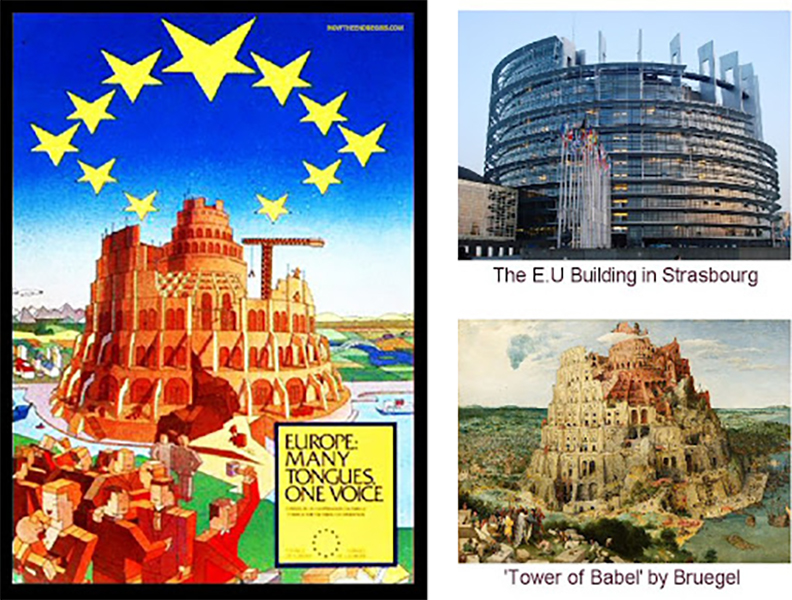Morning Mama
Genesis 10 – THE TOWER OF BABEL – PART 2
July 01, 2020
Cameron A. Bowen
(Part 1 is in the morning manna audio)
Genesis 10:1 - Now these [are] the generations of the sons of Noah, Shem, Ham, and Japheth: and unto them were sons born after the flood.
Genesis 10:2 - The sons of Japheth; Gomer, and Magog, and Madai, and Javan, and Tubal, and Meshech, and Tiras.
Genesis 10:3 - And the sons of Gomer; Ashkenaz, and Riphath, and Togarmah.
Genesis 10:4 - And the sons of Javan; Elishah, and Tarshish, Kittim, and Dodanim.
Genesis 10:5 - By these were the isles of the Gentiles divided in their lands; every one after his tongue, after their families, in their nations.
Genesis 10:6 - And the sons of Ham; Cush, and Mizraim, and Phut, and Canaan.
Genesis 10:7 - And the sons of Cush; Seba, and Havilah, and Sabtah, and Raamah, and Sabtechah: and the sons of Raamah; Sheba, and Dedan.
Genesis 10:8 - And Cush begat Nimrod: he began to be a mighty one in the earth.
Genesis 10:9 - He was a mighty hunter before the LORD: wherefore it is said, Even as Nimrod the mighty hunter before the LORD.
Genesis 10:10 - And the beginning of his kingdom was Babel, and Erech, and Accad, and Calneh, in the land of Shinar.
POLITICO
Europe’s tower of Babel
The inauguration of the Council of the European Union’s Lex building last week marks the latest stage in a drawn-out process of regrouping the institution’s staff in three buildings near the Schuman roundabout in the EU district of Brussels.
By Simon Taylor
Updated 4/12/14, 1:49 PM CET

The inauguration of the Council of the European Union’s Lex building last week marks the latest stage in a drawn-out process of regrouping the institution’s staff in three buildings near the Schuman roundabout in the EU district of Brussels.
The Lex property will house 1,200 Council staff including the 800 translators who are currently working in three buildings scattered across Brussels – Woluwe Heights near the Cora supermarket at the start of the E40 motorway, EspaceRolin at the intersection of Boulevard General Jacques and Chaussée de Wavre, and a site on Place Frère Orban. These three buildings will be vacated now that Lex is available.
Lex’s main purpose is to act as a linguistic nerve centre for the Council and its multitude of working groups of experts. The name was chosen following a survey of staff to reflect the site’s linguistic function. It has seven meeting rooms, two of which are fully equipped with spaces for 150 officials and 29 interpreting booths.
There are currently 23 official languages with the addition in January of Irish, Romanian and Bulgarian. But this number could rise to 29 if Croatia, Macedonia, Serbia, Bosnia and Herzegovina, Albania and Turkey join.
Council’s jurist-linguists who ensure that translations into the official languages are legally correct, will also move into Lex in 2008.
The five other meeting rooms are available for other functions at present but can be equipped for working group sessions if needed. According to Johan Burgers, head of unit for the Council’s buildings policy, ministers could meet in Lex if there were an emergency at the Justus Lipsius.
The building will also house the Council’s archives and libraries as well as a 400-seat canteen which can feed 800 people per session.
In addition to the Council’s translators and jurist-lingusts, Lex will house secretaries, managers, information technology staff, librarians, messengers and security guards.
The construction of the building was not simple. The project manager, Lex 2000 building company, had to deal with the collapse of part of rue de la Loi as well as the discovery of 17th century building remains. Nevertheless the project was completed within the three-year deadline at a total cost to the Council of €262 million. The building itself cost €200m, plus €35m for the land and €27m in fees and other costs. Putting up the Lex building posed major construction difficulties as the site is bounded by streets on two different levels, with a difference of 15 metres in height between the Chausséed’Etterbeek and the higher-up rue de la Loi.
The main pedestrian entrance to the building is on rue de la Loi, but since cars and trucks cannot stop on rue de la Loi, there is a pick-up/drop-off point and VIP entrance on the lower level of Chausséed’Etterbeek.
In line with current urban transport policy which aims to encourage office workers to use public transport rather than private vehicles, there are only 200 parking spaces for the 1,200 occupants.
The property will be the first in Belgium with a reinforced façade, designed after the 9/11 attacks in the US, which, in the event of a bomb attack is supposed to prevent the glass exploding inwards and injuring the occupants.
Part of the Council’s brief was for high ecological performance and the building includes heat pump technologies and cogeneration for combined heat and power. Rainwater is recovered and used in the sanitation system while the lighting is controlled by an energy-saving presence detection system.
The building also has a state of the art sound insulation system to deal with the challenges of the building’s location between a busy inner city road, rue de la Loi, and a train station.
Marc Vankeirsbilck from DexiaBanque, co-owner of Lex 2000, the company which managed the project, said that because the tower building was very compact and did not occupy the entire site, the architects have been able to include public space around on Lex on the Chasséed’Etterbeek level including a garden and a water feature. There are two Japanese-style gardens inside the building on the ninth floor to give staff with offices on the inside natural light and a pleasant view. Two panoramic elevators on the outside of the building offer views of the surrounding area. Part of that panorama will be continuing building work.
The next stage of the Council’s plans is to refurbish the newest part of the Résidence Palace building, which lies between the Justus Lipsius building and the Lex building. It will then become the Council’s main office in 2013. At that point the Council’s military and crisis management staff will vacate 158 Avenue de Cortenberg and the ERM building, designed by Henri Maquet, the architect responsible for the Palais de Justice and the Royal Glasshouses at Laeken.
The Council has been a bit of a travelling circus since the 1970s when it occupied the Charlemagne building, which now houses the European Commission’s external relations, trade and enlargement directorates-general. The secretariat then moved across rue de la Loi to the Justus Lipsius building in 1994, six years after work started.
But the rapid succession of EU enlargements meant that the Justus Lipsius had to be extended, not least because the meeting rooms for ministers’ sessions were only designed for 12 member states and were equipped with only ten translation booths for the then nine official languages. The main meeting room was expanded to accommodate 210 people and 25 languages.
This year the Council covered the entrance to create an atrium with 600 places for journalists covering summit meetings.
news24
Tower of Babel: symbol of unfinished business!
25 Apr 2013
In our day, impressive towering structures are going up everywhere. Just last year, the tallest building in the European Union was inaugurated. That building is The Shard in London standing no less than 309.6m or 1015.748 high!
Let’s go to where it all started! Gen 10: 8-9: ‘Cush begot Nimrod; he began to be a mighty one on the earth. He was a mighty hunter before the Lord.’ Then verses 10-11: ‘And the beginning of his kingdom was Babel, Erech, Accad and Calneh in the land of Shinar. From that land he went to Assyria and built Nineveh, Rehoboth Ir, Calah and Resen between Nineveh and Calah’
Nimrod certainly did not lack ambition. We see that his establishment would lay the foundation for what would be the first rebellion against God. At the time the whole earth had ‘one language and one speech.’ As they were expanding they found a plain in the land of Shinar. The land of Shinar is in the region of ancient Babylon in Mesopotamia, part of modern Iraq.
In Genesis 9:1 we read: ‘So God blessed Noah and his sons, and said to them: ‘Be fruitful and multiply and fill the earth.’ I would think that if anyone who starts a venture wants to expand. However, we see a new strategy put forward in Gen 11:4: ‘And they said: Come let us build ourselves a city, and a tower whose top is in the heavens; let us make a name for ourselves, lest we be scattered abroad the face of the whole earth.’
In other words, the leadership felt that there was somehow in the commandment – remember God is not the business of suggesting - to fill the earth did not resonate with them. Also, one could understand the need to build a tower but why did it have to be so high? Exactly what were they trying to achieve? Nimrod’s ultimate plan was to unite the world. Is there perhaps a modern day phrase that conveys this objective? How about the phrase: ‘New World Order’?
At this stage we will switch terminology and refer to the tower as a ziggurat. What is a ziggurat? The Free Online Dictionary defines it as: ‘a temple tower of the ancient Assyrians and Babylonians, having a form of a terraced pyramid of successively receding stories.’ In other broad base at the bottom but becoming increasingly smaller the higher you go. Let’s explore ziggurats further. ‘Ziggurat designs ranged from simple bases upon which a temple sat, to marvels of mathematics and construction which spanned several stories and were topped with a temple. The Mesopotamians believed that these pyramid temples connected heaven and earth. In fact, the ziggurat at Babylon was known as ‘Etemenankia’ which means ‘House of the platform between heaven and earth’
This reveals that the purpose of the ziggurat’s height was not a practical one, say to as a lookout post to spot approaching enemies. Was this an attempt to reach another dimension? The plan was thwarted when the languages were ‘confused’ and as the result the ziggurat was not completed. Nimrod and his imposter ‘grand architect’ failed with that attempt and he will fail again.
Scholars estimate the construction of Nimrod’s ziggurat to have been around 2350 BC. Did this rebellion end there or do we find in our day a rekindling of those initiatives of ancient times?. Pres George Bush (sr) made the following speech on 11 Sep 1990: ‘Out of these troubled times, our fifth objective – a new world order –can emerge: a new era – freer from the threat of terror, stronger in the pursuit of justice, and more secure in the quest for peace.’ Eleven years later to the day, 11 Sep 2001, his son also President George Bush (jr) was in charge of a nation who suffered an attack of unprecedented proportions and indeed the ‘troubled times’ his father spoke about were intensified exponentially.
In reality the goal of world unification has not died. There is a dogged persistence and determination to make this a reality. Is it then not interesting that theEuropean Union (Revived Roman Empire) Parliament Building at Brussels, Belgium was designed in the form of an unfinished Tower of Babel? Also a stylized Tower of Babel has been used to advertise the European Union’s goal of human unification under the slogan: ‘Many tongues, one voice.’ The EU Parliament was completed in Dec 1999.
It’s almost like someone is trying to settle a score.



















